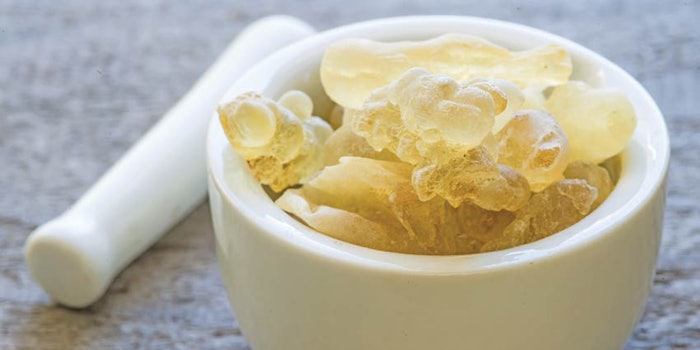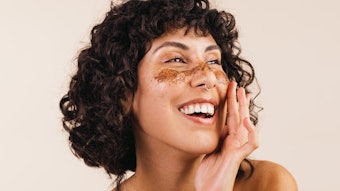
The plant kingdom gives abundantly to address body, mind and spirit. When we peel an orange, rub a sprig of rosemary through our fingers or walk through a rose garden, nature provides us with an aromatic palette of exquisite delights.
In a time when we are seeking to remember to breathe deeply, stay calm in our environment, relax and revitalize, it is not surprising that frankincense has re-entered into our lives.
History
The name frankincense is derived from medieval French “franc” meaning “pure” or “free,” and from the Latin “incensium,” meaning “to smoke.” Frankincense has been used since antiquity as the true aromatic incense. Use of frankincense has been documented as far back as 3000 B.C. From the rocky hillside of Oman, caravans made up of thousands of camels spanned the length of the trail to Petra, Jordan.
"Essential oils have a powerful, transformative effect on the health of all of those that create a relationship with them and incorporate them into their daily lives of wellness, truth, beauty and goodness."
In the ancient world, frankincense was often referred to as “liquid gold.” Frankincense was held in high regard and was found in the tombs of Egypt. The ancient Egyptians imported frankincense in vast amounts, as it was a highly traded commodity bringing great wealth to many. They burned the resin into a powder called kohl and used it as an eyeliner and in rejuvenating face masks. The use of precious frankincense in aromatherapy for both spiritual and healing purposes has been discovered in Petra through excavation of vessels that were tapered to sit on lamps, which released the aroma when lit.
Frankincense was highly regarded for spiritual and domestic use in many cultures, including the Ancient Hebrew, Persian, Babylonian, Greek, Roman and Egyptian civilizations. Known for its antimicrobial properties, it was common for people to place the resin in their mouths and chew it to strengthen teeth and gums.
Origin and varieties
Frankincense is from the botanical family Burseraceae. Frankincense is a small, desert tree with abundant pinnate leaves and white or light pink flowers. When a frankincense tree reaches full maturity, wild harvesting begins.
Extraction of the frankincense must be done with great care and skill. The extraction is created by incisions into the trunk of the tree that form milky-white droplets from the sap or oleo gum resin. The oleo gum resin bleeds out and hardens into a brownish, orange gum called “tears” or “pearls.” Frankincense’s oleo gum resin helps to protect the tree from fungi, viruses and insects, as well as the dry, arid region. Frankincense trees can live to be 100 years old.
There are several species and varieties of frankincense trees, each producing a slightly different type of oleo gum resin. Three of the most commonly used species are Boswellia carterii, Boswellia sacra, and Boswellia serrata. These are used for distillation of frankincense essential oils and are used today in aromatherapy. Frankincense’s essential oil is stored in the oleo gum resin and is either steam- or hydro-distilled.
The most well-known and frequently used frankincense is Boswellia carterii essential oil from Somalia. Frankincense carterii is a viscous, golden amber-colored liquid with powdery, sweet, fruity and resinous notes, and a delicate balsamic undertone. It has a deep, rich, grounding aroma that has many therapeutic properties, such as the ability to quiet the mind, calm nerves and create serenity. The essential oil is high in alpha pinene, and other monoterpenes, making it excellent for immune support.
Boswellia serrata from India has a light, woody, flowery aroma, and is clear when distilled. It is the oldest documented frankincense, and is believed to have been the frankincense referred to in the Bible and Ayurvedic medicine. Frankincense serrata has been used for hundreds of years in India for relieving inflammation caused by arthritis, swelling and allergies.
Boswellia sacra from Oman grows in rocky, dry regions, often along slopes and ravines. It is woody and full-bodied with resinous notes. Because of its sacred nature, it is excellent for meditation, spiritual reflection and prayer. Boswellia sacra creates a feeling of peace, contentment and an overall sense of wellness.
Therapeutic Benefits
Frankincense is fast becoming the most researched essential oil. Like all therapeutic essential oils, frankincense is made up of many chemical constituents that work together to create a healing synergy. Frankincense’s wide array of benefits help to restore the body to health. Frankincense essential oil contains nearly 60% monoterpenes, which is mostly alpha-pinene. Monoterpenes are antibacterial, antifungal, analgesic, antiviral, antiseptic, astringent and anti-inflammatory. These compounds work holistically and synergistically to support health and wellness. Frankincense works with the human body to cleanse, protect and strengthen our immune function and support our natural healing processes.
Because of frankincense essential oil’s anti-inflammatory properties, it has an affinity with the lungs for respiratory conditions including asthma, allergies and sinus conditions. Frankincense supports the whole musculoskeletal system—joints, muscles, ligaments and structural tissues including bones.
In Skin Care
Frankincense is nourishing and cell regenerating by nature, making it ideal for all skin types, especially mature, dry or dehydrated skin. Because Frankincense works directly on inflammation and wound healing, it is excellent for acne, scarring, rosacea and age spots. Hydrating masks made with a few drops of frankincense essential oil will hydrate and boost cell regeneration.
Frankincense hydrosol—“hydro,” meaning water and “sol,” meaning solution—is the first portion of distillate from the distillation of the oleo gum resin. This water carries cellular waters from plant cells, water-soluble minerals and balances the pH of the skin. Frankincense hydrosol can be used in a steamer, as an extra in powdered masks, before and after any treatment, and as a retail product. Encourage your client to use as a toner by spritzing on before moisturizing and to set makeup. Carry it in a bag and refresh and balance both physically and emotionally throughout the day.
Massage Therapy and Bodywork
When giving massage or bodywork, we relax, stimulate, rejuvenate and restore the body to balance through physical touch. There are many modalities that we use to create this change. When adding therapeutic frankincense essential oil to our repertoire, we begin the relationship of integrating subtle, yet profound deeper levels of communication to the body through our olfactory senses. Therapeutic frankincense essential oil takes clients to a place of tranquility and peace. It quiets the mind and relaxes the nerves. It slows down the breath and rebalances our spiritual, mental and emotional health.
One of frankincense essential oil’s most important qualities is on the nervous system. It relaxes, yet revitalizes making it excellent for nervous tension and exhaustion. Frankincense stimulates the lymphatic system and strengthens the immune system, and is excellent for stretch marks, cellulite and varicose veins.
Home Care
Diffuse. Encourage clients to use frankincense at home in their diffusor to create a sense of calm and balance. It is particularly beneficial when practicing yoga or meditation. The oil will open the chest and deepen the breath.
Stimulate. Add a few drops to a dry brush to stimulate the lymphatics.
Relax. Add a few drops to a relaxing bath and light a candle.
Refresh. Use Frankincense hydrosol to refresh, hydrate, balance the pH and for an attitude adjustment.
Practitioner Care
Essential oils have a powerful, transformative effect on the health of all of those that create a relationship with them and incorporate them into their daily lives of wellness, truth, beauty and goodness. Breathe and let go.











